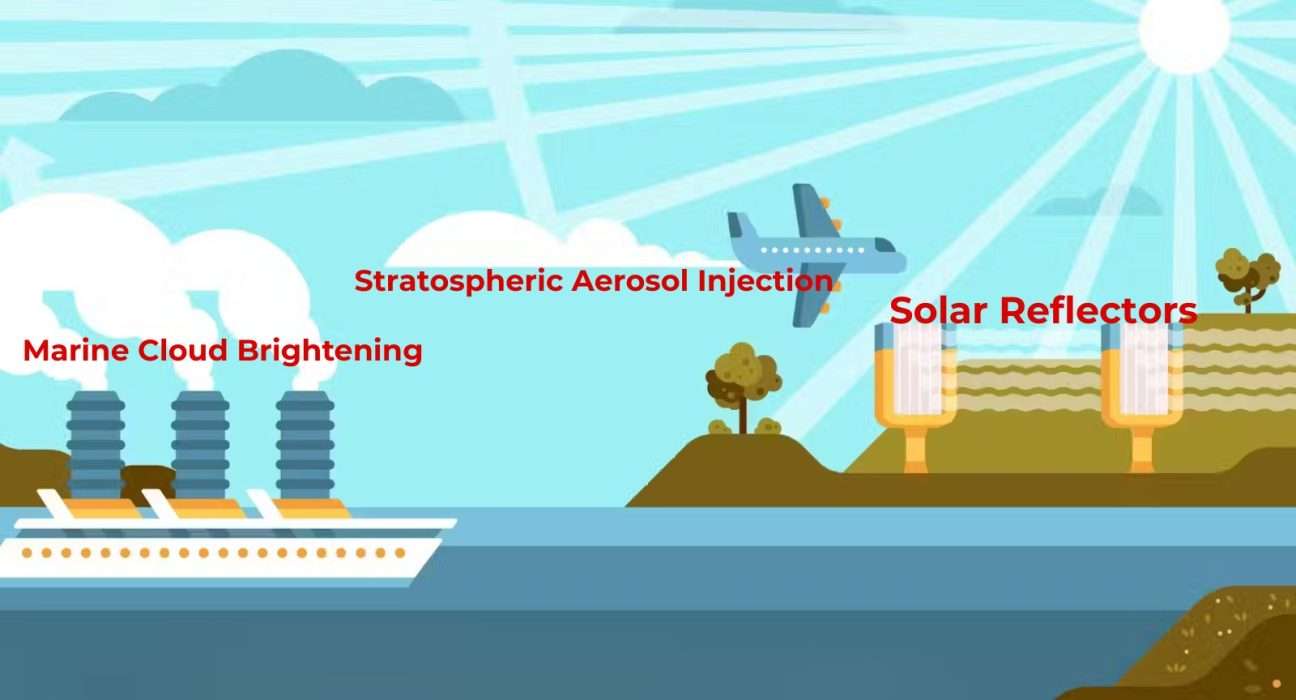When scientists talk about “dimming the planet,” they do not use analogies. Instead, they refer to solar geoengineering, which includes intentionally reflecting a portion of sunlight into space to cool the Earth, and has moved from science fiction to actual policy discussions. Proposals such as pumping aerosols into the stratosphere, brightening marine clouds, and installing reflecting particles in the high atmosphere are now receiving research funding in the United States, Europe, and China. Supporters argue that these tactics could temporarily lower global temperatures and buy time in the climate struggle. While critics claim this might have unintended ecological consequences, aggravate global inequality, and trigger geopolitical crises over who controls the planet’s thermostat.
The Rise of Solar Geoengineering
The climate catastrophe is worsening quickly than expected. Record global warming, harsh weather, and rapid ice melt are prompting some to contemplate more drastic solutions. In this context, solar geoengineering, particularly Solar Radiation Management (SRM) technologies, is gaining popularity in scientific and policy circles, not as a replacement for mitigation, but as a contentious “backstop.”
The most extensively investigated SRM method is stratospheric aerosol injection (SAI). The objective is to inject particles (such as sulfur aerosols) into the stratosphere, simulating volcanic eruptions, to reflect some inbound solar radiation and cool the Earth. While the exact costs are unknown, SAI funding appears to be very inexpensive compared to the expenses of large-scale decarbonization. The fact that SRM may be technically viable does not mean it is politically or ethically straightforward.
The geopolitics of thermostat wars
Geoengineering poses serious political and ecological risks. Here are a few flashpoints to watch:
1. Regional Climate Side Effects
Even if SRM reduces global average temperatures, the impacts may be unequal. Climate-modeling studies imply that aerosol injection could impair monsoon systems in South Asia, lowering precipitation and jeopardizing food security for billions. For example, a 2025 study published in the journal Climate and Atmospheric Science suggests that stratospheric aerosol intervention will likely reduce mean and extreme summer monsoon precipitation throughout South Asia through mechanisms such as stratospheric warming and jet shifts.
Another study on the Indian Summer Monsoon suggests that under a geoengineered scenario, precipitation may fluctuate regionally (favoring specific places), and that abrupt termination would result in quick shifts back to a warming baseline — only referred to as a “termination shock.”
These asymmetries raise the risk of interstate claims of harm: if India or Bangladesh suffers drought or crop failures due to someone else’s SRM deployment, could that be deemed an act of aggression?
2. Unilateral action by major powers
The U.S., China, and other technologically advanced states have conducted research or small-scale geoengineering tests. Voices in these countries have already started arguing the case for national security dimensions of climate control. If a large state deploys without a multilateral agreement, it causes diplomatic crises and legitimacy issues in global climate governance. Though contentious, the prospect of giving climate manipulation a geopolitical or coercive dimension cannot be entirely discounted. Even if SRM is portrayed as benign and global, the notion that a state can “turn down the thermostat” adds new dimensions to authority. Some fear that climate control may become a geopolitical tool, or that opposing powers will exploit vulnerabilities.
Global South and Climate Colonialism
Vulnerable states in the Global South face a paradox: they are the most susceptible to climate change, but have the least say in guiding SRM research and deployment. This lays the groundwork for climate colonialism, in which powerful governments or actors determine how to “engineer Earth” — with weaker states bearing the costs. Most SRM science is dominated by Global North institutions, with little participation from developing countries. While, lack of compensation or reparation mechanisms raises the query, who is responsible for any harm caused? There is no clearly defined responsibility regime. Many developing countries are concerned that an overreliance on SRM may divert political and financial resources from reducing emissions. Voices from the Global South have already responded. India has consistently warned against techno-fixes that divert attention away from mitigation efforts, while many African and island delegations have expressed reservations about legitimizing geoengineering projects.
The Role of Non-State Actors
Not all possible deployers will be nations. Universities, tech businesses, and billionaire-funded organizations are already investigating components of SRM. For example, the withdrawal of Harvard’s SCoPEx (Stratospheric Controlled Perturbation Experiment) due to opposition from the indigenous community highlights the limitations of social consent. Private companies have proposed small-scale aerosol discharge experiments (e.g., “Make Sunsets”), avoiding regulatory clearance. If private actors chose to experiment with planetary systems, standard state-centric governance frameworks may not be adequate to intervene or regulate.
Norms, Treaties, and the Path Forward
A Global Moratorium or Non-Use Agreement mentions that some climate scientists and non-governmental organizations (NGOs) propose a binding prohibition on deployment until more is known. Frank Biermann and colleagues, for example, have advocated for a worldwide non-use agreement for solar geoengineering, which over 500 experts have signed. Further, in terms of Governance Frameworks, many propose a multilateral protocol to control experiments (e.g., thresholds, transparency, stakeholder inclusion), but prohibit full-scale implementation until global consensus is reached. Inclusion under UN or Treaty supervision involves proposals that range from incorporating SRM governance into current climate bodies (such as the UNFCCC) to establish new institutions for supervision.
Lastly, Precautionary and Participatory Norms that prioritize public engagement, transparency, and the precautionary principle before deployment are needed. Still, creating such frameworks is difficult. Preventing action (unilateral deployment) is sometimes more difficult in international politics than encouraging cooperation.
Ethical dilemmas and intergenerational justice
Beyond geopolitics, there are deeper ethical considerations. If SRM must be maintained continuously, subsequent generations will be subject to constant interventions. Stopping an SRM program prematurely—or if global coordination fails—could result in sudden warming (termination shock), with serious repercussions.
Furthermore, SRM ignores ocean acidification, biodiversity loss, and the underlying causes of climate change. It provides symptom masking rather than structural transformation. The potential of “moral hazard” – in which mitigation efforts dwindle due to dependence on a technological repair — is hotly disputed in climate ethics. Geoengineering adds another layer of moral stress to an already fraught environment of contentious global decisions.
India’s Strategic Dilemma
India’s stakes are exceptionally high. As a climate-vulnerable state, it is susceptible to monsoon disruption, glacial melt, heat stress, and sea-level rise. However, as a growing power, it cannot afford to lose influence in choices on planetary intervention. A strategy study for 2024 emphasizes how Indian scholars and institutions advocate for strong national policies on SRM research and engagement in global governance.
India has avoided active SRM implementation, preferring mitigation, adaptation, and renewables. However, if a significant event initiates SRM, India will experience direct climate consequences (such as altered monsoon patterns). According to research, SAI can potentially cause South Asian monsoon rainfall, resulting in significant agricultural and social costs. As a result, India may eventually need to engage in its own geoengineering modeling and monitoring—not to deploy, but to contest, audit, and participate in governance.
Conclusion: Who owns the sky?
The central question with geoengineering is deceptively simple: Who owns the sky? Unlike emissions, where responsibility is shared, geoengineering entails purposeful human control over planetary systems. Decisions made in Washington, Beijing, or Silicon Valley can impact rain, Lagos, and São Paulo. Geo rainfall engineering is fundamentally about power, rather than technology or the environment. Who sets the global temperature, whose voices are heard, and whose risks are overlooked? Unless the world quickly creates inclusive norms and binding treaties, the likelihood of “thermostat wars” will increase.
History demonstrates that strength prevails when disruptive technologies arise without governance, while the weak bear the costs. To Geoengineering, governance must be based on justice, discussion, and transparency.
To prevent climate colonialism in the twenty-first century, dimming the sun will increase as the world heats up, unless humanity addresses the power issue, engineering risks becoming a geopolitical powder keg rather than a lifeline.






